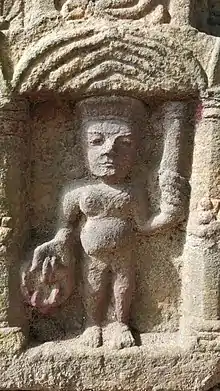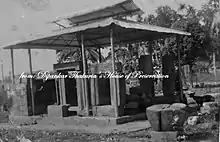Chand Sadagar
Chand Sadagar, (Assamese:চান্দ সদাগৰ, Bengali:চাঁদ সদাগর), was a rich and powerful river and sea merchant of Champak Nagar in Eastern India. This merchant has been claimed by both the Bengali and Assamese people of India to be associated with their respective states and communities. Medieval Bengali poet Bipradas Pipilai mentioned in his "Manasamangal Kavya" or "Manasa Vijay" that merchant ship of Chand Sadagar used to proceed to the sea from ancient Champaknagar of Bengal after passing through Tribeni, situated at the junction of Saptagram and the confluence of Ganges, Saraswati and Jamuna River of modern-day West Bengal.[1] Narayan Dev gave an account in his Manasamangal about the merchant ship of the trader Chand Saudagar proceeding to the sea from ancient Champaknagar of Assam passing through Saptagram and Tribeni, the tri-junction of the Ganges, Saraswati and Jamuna River.[2] In the Padmapuran ( Hindu Scriptures), account of Chand Bania ( Sadagar) is specifically mentioned.
Chand Sadagar (
অসমীয়া- চান্দ সদাগৰ, বাংলা- চাঁদ সদাগর) | |
|---|---|
 | |
| Born | Chandradhar 200–300 AD Champak Nagar, Eastern India |
| Occupation | Ancient merchant |
| Known for | Medieval Assamese and Bengali folklore and historic character |

Mythology
According to Bengali literature of Manasamangal genre, like Bipradas Pipilai's "Manasa Vijay" (মনসা বিজয়), Ketakadas Kshemananda's "Manasar Bhasan" (মনসার ভাসান), etc. and Assamese literature Manasamangal Kāvya, or Padma Puran ( পদ্মা পুৰাণ) Chand Sadagar was an ardent devotee of Shiva but Manasa had set her mind on making him a devotee. She tried all the tricks to force Chand Sadagar to change his mind but he was equally determined and protected himself with the mantras or mystic words he had received from Shiva. However, when Manasa appeared to him as a beautiful woman, he let her know his secret. Thereafter, he lost his supernatural powers that came with the mystic words. He then took the help of Sankara, whose capabilities were more than even his when he had full powers, but Manasa killed him and made Chand Sadagar helpless again.
When Chand Sadagar still refused to be intimidated into worshipping Manasa, she started sending serpents that killed all his six sons. His trading interests collapsed as he did not have the heart to look after them properly. Even in the midst of such adversity, his determination revived and he set out on a sea voyage to rebuild his business. After a successful business tour he set sail for home, his ship laden with treasure. Manasa launched a storm, and although Chand Sadagar initially survived with support from Chandi, she was later asked to withdraw by Shiva on a request from Manasa. Once that happened Chand Sadagar's ship was wrecked, but Manasa swept him ashore at a place where an old friend Chadraketu lived.
Chandraketu tried his best to bring him round to the goddess Manasa but Chand Sadagar steadfastly refused. He became a beggar and lost everything but still worshipped only Shiva and Durga, refusing to bow to Manasa, who felt that she could never win over Chand Sadagar on her own and took the help of two friends in heaven – two Apsaras. They agreed to be born on earth, one as Chand Sadagar's son and the other as the daughter of Saha, a business associate of Chand Sadagar.
Lakhindar and Behula

Having returned to Champak Nagar, Chand Sadagar managed to rebuild his life. A son was born to him. They named the boy Lakhindar . At around the same time Saha's wife gave birth to a daughter, whom they named Behula. Both the children grew up together and were a perfect made-for-each-other, but when their horoscopes were tallied, it was predicted that Lakhindar would die of snake-bite on the wedding night. However, as both the children were already devotees of Manasa and were so well matched that the marriage went ahead. In spite of all the precautions, Manasa had her way, one of the snakes, sent by her, killed Lakhindar.
To get back her husband's life from the Gods in the heavens, Behula sailed with her dead husband in a raft towards Heaven. She faced many dangers during her incredibly long and difficult journey. After she pleaded with the goddess, Manasa said, "You deserve to have him back, but this can only be done if you promise to convert your father-in-law to my worship". Chand Sadagar reluctantly agrees.
Chand Sadagar worshipped Manasa on the eleventh day of the waning moon every month. He could not forgive the goddess for all the suffering he had to go through. He offered her flowers with the left hand and turned his face away from her image. Manasa did not hold anything against him for that. From then on Chand Sadagar and his family lived in peace and prosperity. Chand Sadagar's status and prestige ensured that the worship of Manasa became generally accepted and respectable.
Champak Nagar
Champak Nagar of Chand Sadagar has been claimed by both the Bengali and Assamese people of India to be situated in their respective states.
Bengali Version
According to the local folklore of West Bengal Champainagari, or Kasba-Champainagari, situated in the Purba Bardhaman district of West Bengal is the Champak Nagar of Chand Sadagar. The locals believe that the place is associated with Ma Manasa and Chand Sadagar. In "Ain-i-Akbari" also the name of Champainagari Pargana under Sarkar Madaran has been mentioned, which was located in the present Purba Bardhaman district of West Bengal. Kasba-Champainagari is located on the north bank of Damodar River, approx. 32 miles west of Bardhaman city and south of Budbud. We know from the story of Manasamangal that Chand Sadagar was a straunch Shaivite and he even built a Shiva temple in his house. According to the local folklore of this village, the two Shivalingas (one of which is Rameshwar Shivalinga) resting in two ancient Shiva Temples situated in this village of Purba Bardhaman were established by Chand Sadagar himself. There is a beautiful Shiva temple on a high mound situated to the south of the DVC canal. The Shiva temple, located next to a huge Ashwattha tree, has a huge Shivalinga (without the Gauri Patta), known as Rameshwar Shivalinga. There are also two high mounds in the village, one of which is believed to be the ruins of Behula's Basarghar (Sati-Tirtha) and Chand Sadagar's house.[3][4]
Sundarban Tiger Reserve of West Bengal, is associated as the place where Neti, foster mother of Ma Manasha, lived and worked as a washerwoman. A temple at Howrah, a Kolkata neighborhood, is believed to have been built by Chand Sadagar.
Between the citadel and the eastern embankment at Gaur, a ruined structure, is claimed to be the house of Chand Sadagar.[5]
Assamese Version
According to Assamese folklore, Champak Nagar is placed in Chaygaon, Kamrup,About 30-40 km from Guwahati (Assam)[6] Champak Nagar is still there in Chaigaon area of Kamarupa in Assam. To escape from the plight of Ma Manasa, Lakhindhar and Behula escaped to a place called Gokul Medh, 3 km south of Mahasthangarh and 9 km north of Bogra town, 1 km from the Bogra-Rangpur road of modern Bangladesh. After Behula Behula's Basarghar or Lakhinder's Medh. During excavations here in 1934–36, 162 rectangular abattoirs were found in a lined courtyard. It was built in the sixth or seventh century AD. According to local folklore, this place is associated with Behula and Lakhinder. The remains of a temple have been found 800 meters west of the north-west corner of the ruins at Chengispur village in Mahasthangarh. It is called Khullana mound. The Karatoya River, which flows through the region, is now narrow but is known to have been huge in the past. There is a region in Dhubri district of Assam, much north of Bogra. The area is believed to be reminiscent of Mansa's companion leader.
In popular culture
In 1927, Manmatha Roy wrote the mythological Bengali play Chand Saudagar, portraying the title character.[7]
In 1934, Prafulla Roy directed a Bengali film Chand Saudagar in which Dhiraj Bhattacharya played the role of Lakshmindara, Ahindra Choudhury that of Chand Sadagar, Devbala of Manasa, Sefalika Devi of Behula, Jahar Ganguli of Kalu Sardar, Indubala of a singer, Niharbala of Neta Dhobani, Padmabati of Sanaka and Usharani of Amala. It was written by Manmatha Roy. Film editing was by Akhil Neogi.[8]
In 2010, STAR Jalsha create a Bengali serial "Behula".
Amitav Ghosh's novel Gun Island deals with Chand Sadagar.
References
- Roy, Niharranjan, Bangalir Itihas, Adi Parba, first published 1972, reprint 2005, p. 75, Dey’s Publishing, 13 Bankim Chatterjee Street, Kolkata, ISBN 81-7079-270-3
- Miller, Frederic P.; Vandome, Agnes F.; John, McBrewster (2010-11-01). Chand Sadagar. VDM Publishing. ISBN 978-613-2-81452-4.
- Chowdhuri, Jagyeswar (1994). Bardhaman Itihas O Sanskriti Vol.3 (1994 ed.). Calcutta: Pustak Bipani. p. 239.
- Bhattacharya, Hansanarayan (1998). Paschimbanga Darshan-4 Bardhishnu Bardhaman (1998 ed.). Calcutta: Farma K. L. M. Private Limited. p. 263.
- Ray, Aniruddha (2012). "Gaur, City". In Islam, Sirajul; Jamal, Ahmed A. (eds.). Banglapedia: National Encyclopedia of Bangladesh (Second ed.). Asiatic Society of Bangladesh.
- Kanak Lal Barua, Early history of Kāmarupa,1966 Kamarupi trader named Chand Sadagar whose home was in Chaygaon in modern Kamrup, on the south bank of the Brahmaputra
- Ahsan, Nazmul. "Roy, Manmatha". Banglapedia. Asiatic Society of Bangladesh. Retrieved 2007-12-12.
- "Chand Saudagar". citwf.com. Archived from the original on 2012-02-08. Retrieved 2007-12-12.